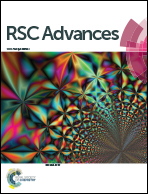Deep eutectic solvent based on sodium cations as an electrolyte for supercapacitor application
Abstract
This study proposes a new deep eutectic solvent based on sodium nitrate and N-methylacetamide as an electrolyte for carbon-based supercapacitors at 80°C. The reversible intercalation of ions into the graphitized ultra-micropores of activated carbon, separately detected at negative and positive electrodes, permits high pseudo-capacitance (up to 302 F g−1). The SEM/EDX mapping and XRD profile show homogeneous distribution of Na in negative polarized electrodes indicating that sodium is well incorporated in the ultra-micropores of the carbon structure. The good capacitance obtained at 80 °C in two-electrode cells at an operating voltage up to 2.0 V remained stable after 1000 charge–discharge cycles. Based on its physicochemical properties, as well as its electrochemical performances and stabilities, the sodium based DES can be considered a promising electrolyte for supercapacitor applications.


 Please wait while we load your content...
Please wait while we load your content...